
Health Monitoring in Real Time
Written by Carolina Worrell, Senior Editor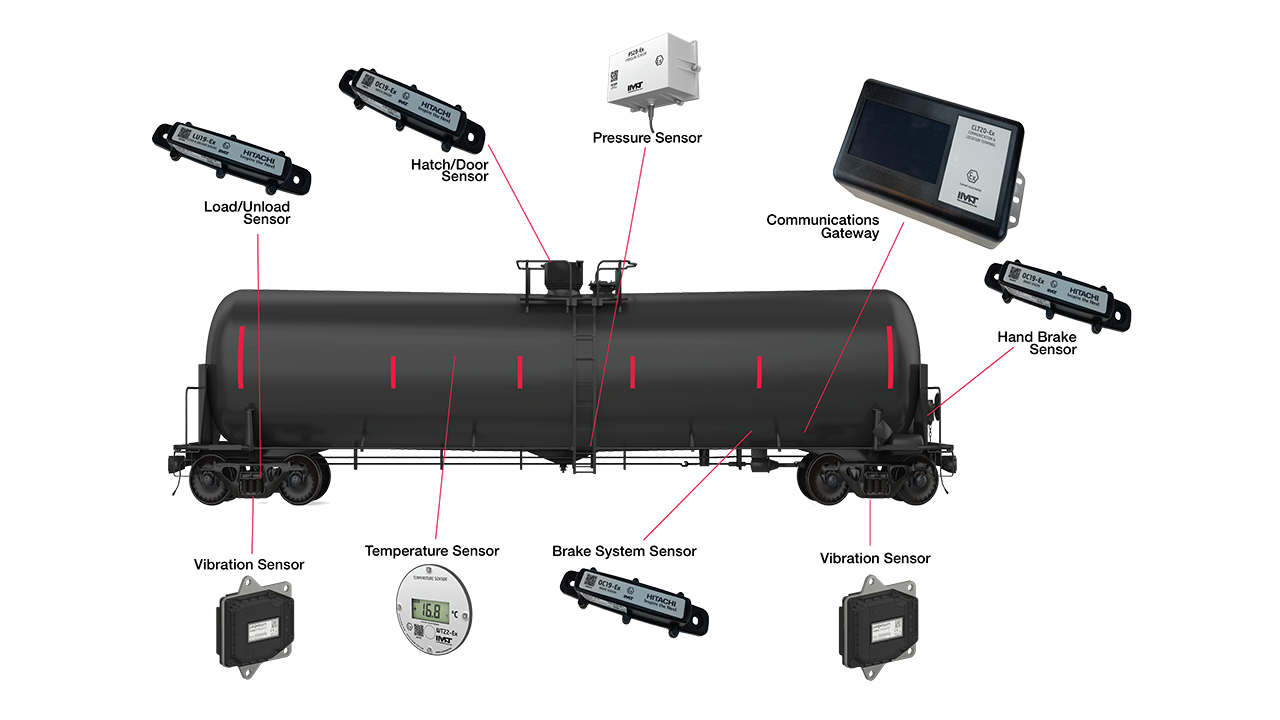
Hitachi Rail’s full rail telematic solution provides gateways and sensors with proven technology and data processing capabilities.
RAILWAY AGE AUGUST 2022 ISSUE: Artificial Intelligence, supported by continuous communications, is rapidly turning “fix it before it fails” into the industry’s mantra.
When railroads, either in-house or through supplier-provided contracted services, perform remote train health monitoring, potential equipment problems on freight cars or locomotives can be identified and reported back to a control center in real time by Artificial Intelligence (AI)-based onboard technology before they become catastrophic. This is especially important for railcars carrying hazardous materials—the more information the user has while the car is in transit, the safer it is.
Among the suppliers providing this health monitoring technology are Wabtec, Hitachi Rail, Amsted Digital Solutions (ADS), Progress Rail, Wi-Tronix, ZTR and Nexxiot.
Wabtec
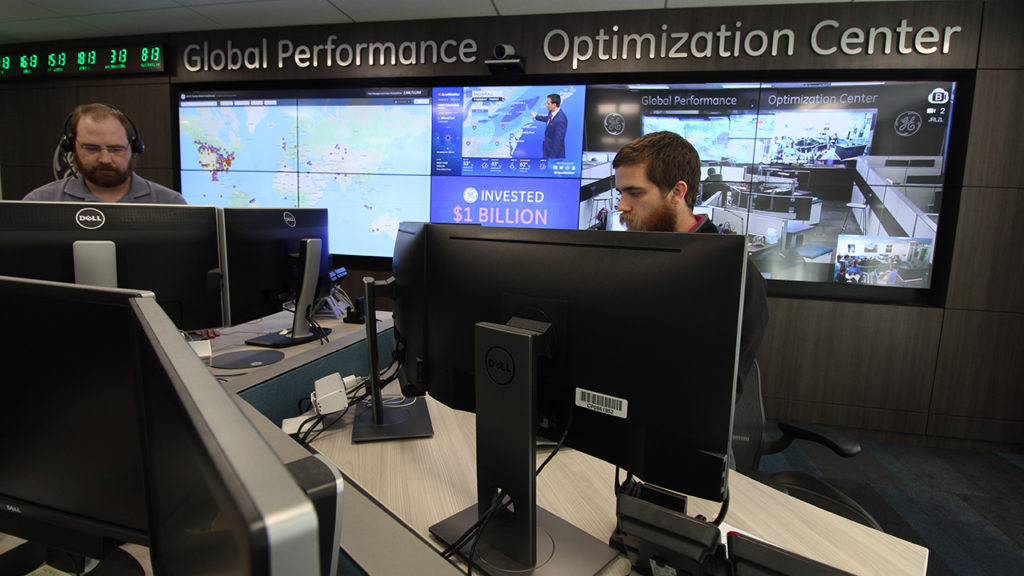
Wabtec conducts freight locomotive monitoring at its four Global Performance Optimization Centers (GPOCs) located in Erie, Penn.; Fort Worth, Tex.; Brazil; and Kazakhstan. Collectively, the four centers serve more than 50 customers operating in 20 different countries and monitor 17,000 locomotives worldwide.
The GPOCs, which operate 24/7 and are manned by a team of three to four experts (per shift) who average more than 15 years of hands-on troubleshooting experience and provide true condition-based repair instructions, address about 80% of failures that can impact a locomotive. Experts issue about 300 Rx’s (a detailed troubleshooting instruction for a specific issue on a specified road number) per day covering the engine, propulsion, auxiliaries, computers, communications, crew interfaces and train control systems. Various field teams then execute the Rx and provide feedback on the work done.
The centers receive approximately 2.5 million messages a day. Digital tools (knowledge rules, digital twins and machine learning) process these messages into around 500 “cases” a day, which are then reviewed by onsite experts. The time between when an alert message is received to when an Rx is issued is no more than 15 minutes.
The GPOCs then review feedback from the field—key to keeping the system “learning” and improving every day—and close each Rx case. The centers also field approximately 150 calls a day to work with the field on troubled locomotives. Calls are addressed in the native language of the country where the GPOC is located.
In addition to Wabtec locomotives, Wabtec also provides services on non-Wabtec locomotives, off-highway vehicles, marine vessels and stationary power systems.
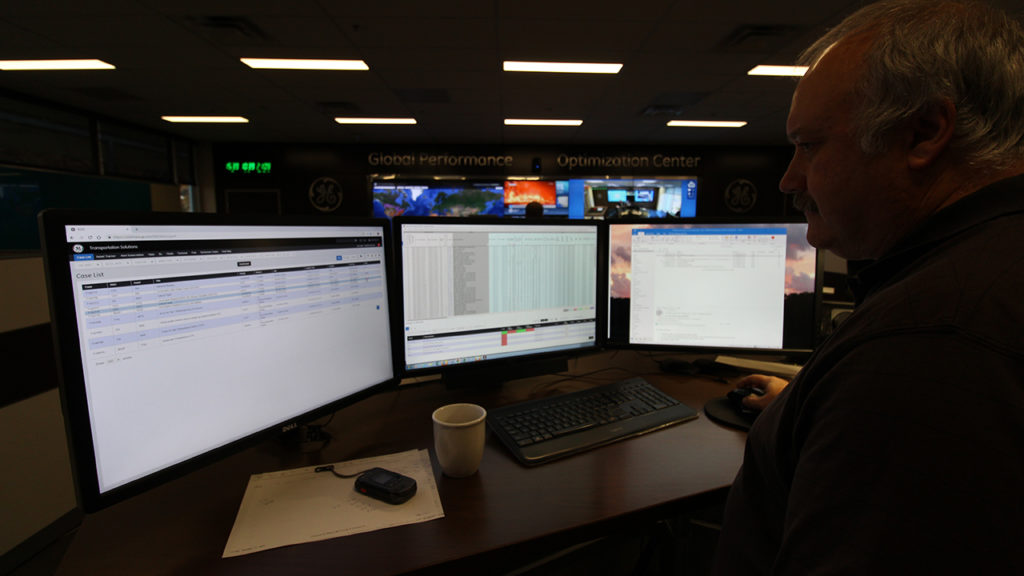
According to Wabtec, benefits of remote health monitoring to customers include:
- Precise, accurate repair recommendations improve service quality and “repeat failures” are dramatically reduced.
- Advanced notification of imminent failures allows customers to proactively route locomotives for repair and avoid main line failures and train delays.
- Having advanced notices allows shops to pre-plan labor, parts and locomotive placement, dramatically reducing “unavailability.”
The computer- and GPOC-generated Rx also saves shop labor by reducing troubleshooting time.
All customers benefit from the GPOC’s centralized learning capability. The GPOC is like a central “doctor” that analyzes all failure modes. This knowledge is shared with all customers (independent of fleet size or age).
These benefits improve locomotive reliability and availability by more than 20%.
Hitachi Rail
Hitachi Rail has partnered with Dutch supplier Intermodal Telematics (IMT) to offer a railcar telematics solution, combining technology from IMT and British rail technology firm Perpetuum, which Hitachi acquired in April 2021, “with the global scale and rail expertise of Hitachi Rail,” the company says.
Hitachi Rail is using remote condition monitoring systems on fleets in North America, Australia and across the world. By installing digitally connected sensors on a variety of critical train components, the company says it is helping operators identify wear and tear remotely, provide insight into the performance of critical assets, and pinpoint and fix faults before they impact operations.
“Our technology is helping passenger and freight rail operators to improve performance, reduce their maintenance costs and enhance safety,” the company notes. “Hitachi Rail is pioneering an entirely digitally connected transport system that can be optimized to be more efficient, reliable and sustainable.”
“We are excited to be bringing our new railcar monitoring solution to North America with our partner, IMT,” adds Miles Metschke, Head of Freight Rail for Hitachi Rail, North America. “The combined products, software and capabilities of both companies creates a best-in-class solution for railcar owners, rail shippers and railroads.”
Both Hitachi Rail (Perpetuum) and IMT, which have been working together for several years as co-members of the IEEE Intelligent Transportation Systems Society (ITSS) practice group for railcar telematics in Europe, say they see close collaboration as the means of bringing a broader suite of telematics driven benefits to the freight rail market in a faster and more cost-efficient manner.
The full rail telematic solution provides gateways and sensors with proven technology and data processing capabilities. It includes:
- Communications Gateway (CLT20-Ex) – a communication terminal (gateway) that monitors the geographic position of the railcar, the movement and motion (shocks and normal movement) of the railcar, and the temperature of the gateway device.
- OC19-Ex – a hatch, door and brake sensor that detects the position of hatches and doors on tank cars and covered hoppers by measuring the angle of the sensor on the door, and on the position of hand brakes on bell crank style brake systems.
- LU19-Ex – a load/unload sensor that detects the loading state of railcars by measuring the displacement of a railcar on its trucks, which is usually determined by the weight of the material in the railcar.
- WASN2-43 – a truck condition health (vibration) sensor that monitors the condition of the railcar wheels, bearings and axles at the truck level. This sensor, which is powered via harvested vibration energy from the railcar and converted to electrical energy, uses vibration data to determine the overall health of the truck components and can determine when a component needs to be inspected, maintained or replaced.
- WT19-Ex – a digital, non-intrusive temperature sensor for tank cars used to monitor the temperature of a tank’s contents and send the measured temperature values wirelessly to the CLT20-Ex, which in turn transmits the sensor data to the software platform back-end where it can be accessed remotely via a web application.
- PS20-Ex – a pressure sensor that is to be used together with third-party, compatible pressure transmitters to create a digital pressure sensing solution for tank cars. Its purpose is to monitor the pressure inside of a tank car and to send the measured values wirelessly to a CLT20-Ex, which in turn transmits the sensor data to the software platform where it can be accessed remotely via Hitachi’s web application.
As part of the overall system architecture, the software backend platform is used to collect and manage data from the CLT20-Ex Gateway devices. This software, which is designed to be integrated in the existing IT infrastructure of Hitachi Rail customers, is described as “a mature platform that provides several capabilities required for railcar telematics.”
A two-way flow of data is made possible by the RESTful Application Programming Interface (API), which allows its customers to feed in other IT systems, such as TMS, ERP, CLM and asset base data. The software API allows access to all device and sensor data together with processed data, such as statuses and events.
Amsted Digital Solutions (ADS)
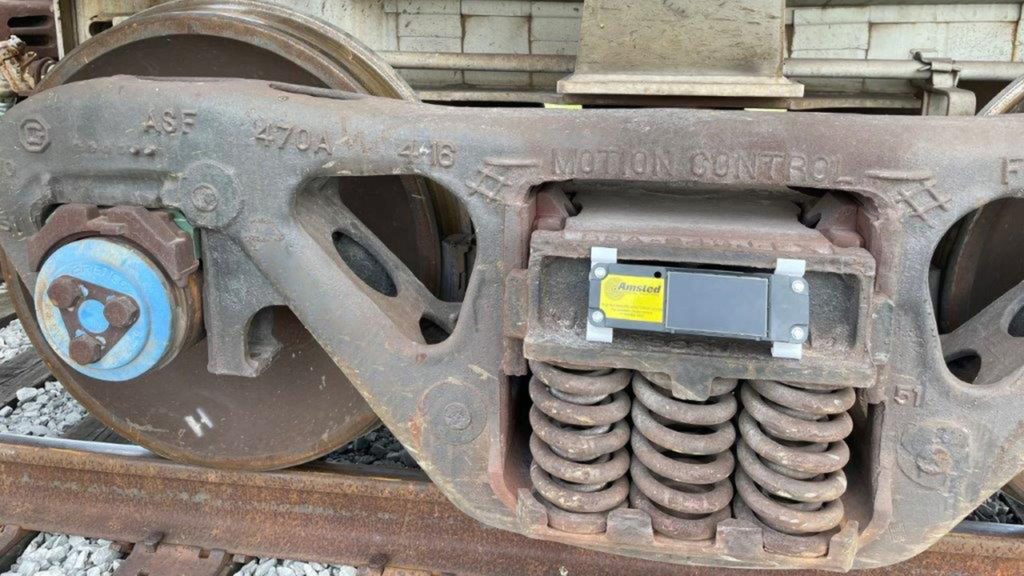
ADS, a subsidiary of Amsted Rail based in Chicago, released in 2Q22 the Bogie IQ™, a global internet of things (IOT) technology focused on freight rail leveraging its SCV™ (Supply Chain Visibility) software, which provides a “quick and easy” means to identify individual railcars within one of three categories: typical, atypical and inspect.
Bogie IQ™, part of the ADS IQ Series of devices, is an onboard telematics device capable of monitoring the changing wheelset conditions and brake system performance by analyzing vibrations. One device per bolster can provide real-time onboard health monitoring while also delivering the GPS benefits of dynamic ETA, first- and last-mile validation, and accurate mileage. Key features include reporting up to every 15 minutes, a proprietary power supply that provides a minimum of seven years of device life, and forward compatibility with 5G technology so an organization’s investment in the onboard technology is protected. They are ruggedized, low profile ATEX Zone 1 and Class I, Division 2 devices. ADS says installation and association of the IQ Series takes only a few minutes per railcar using built-in object character recognition (OCR) and barcode scanning.
“This first-of-its-kind technology delivers 80% of the value for only 20% of the cost,” says Dr. Todd Snyder, ADS Director of Sensors and Analytics. “We have been evolving our design and field testing for years now, both at the Transportation Technology Center (TTC) and in captive revenue service with key strategic railroad and shipper partners, knowing that the freight rail operating environment is a tough one. We are excited about our initial release and other future innovations already in development that can be pushed out to our devices through a firmware over the air (FOTA) update.”
“We recognize that multiple sensors distributed around a truck system can be costly, as well as difficult to deal with in the field because they could be damaged or displaced,” says Byron Dickey, Vice President-Strategic Development. “We quickly determined that we needed to ensure our development path considered the practicality of how the North American free interchange system works in terms of the maintenance of running components. We cannot impede railroad operations.”
ADS and Amsted Rail combine research and development facilities, which are utilized to support ADS’s innovations and product developments, across North America, including its impact test tracks located in Camp Hill, Penn.; its bearing test facility located in Petersburg, Va.; and a proprietary multi-axis load (MAL) machine, which allows Amsted Rail to apply loads across multiple axes to an entire assembled freight car truck system, located in Granite City, Ill. Notable ADS products include Motion Control® truck system, Brenco® tapered roller bearings, Griffin® cast steel wheels, former Ellcon-Faiveley conventional brake systems, and Axis axle components. “This valuable and unique relationship makes ADS the global leader in merging onboard IOT technology with real-world freight railway experience in diagnosing component health,” says ADS.
“ADS is focused on the shipper and the maintenance responsible parties (MRPs) so that these segments of the market can benefit from what the Bogie IQ™ device platform can deliver,” says Executive Vice President and Chief Operating Officer Brad Myers. “We provide the MRP with visibility into the health of freight car components, while delivering GPS location data for our shipper customers to manage inbound empties, outbound high priority loaded cars, and first- and last-mile verification. This can impact invoicing, demurrage and detention billing. This is the first wave of maximizing value from a transportation software platform like ADS’s Supply Chain Visibility solution.”
The information provided from the SCV™ software application for Bogie IQ™ wheel and brake health is merged with GPS and waybill data, providing users with “an efficient way to manage by exception and have actionable information immediately,” ADS says. The entire SCV™ platform leverages the ADS OneVue™ business intelligence tool, a custom reporting tool that allows users to create relevant views inside each software application that summarizes their key data sources. Once a user builds a custom view it can be shared across their organization.
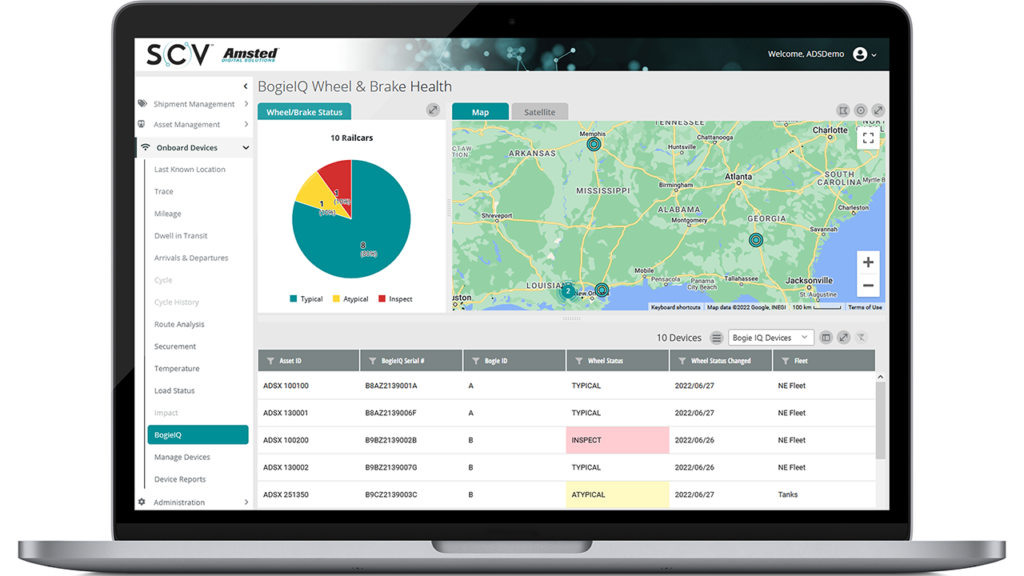
“We are leveraging our latest technology stack built on Microsoft Azure. It’s a scalable, flexible and secure platform that allows us to bring in data from multiple data sources or push data to systems like an ERP,” says Evan Weiner, Vice President-IOT Technologies. “If needed, we can also consume third-party onboard device data. These are just a few areas where we deliver real value for our customers.”
“This is an exciting year for ADS,” adds Myers. “We are rolling out our newest version of the SCV™ software platform and integrating key software capabilities that are very shipper-focused from our acquisition of the GeoMetrix Rail Logistics assets, among other exciting additions to our capabilities.”
ADS says it has also expanded its offerings to include professional services for customers, such as fleet management resources to assist in managing a railcar fleet, from shopping events to scheduled maintenance programs or analyzing fleet utilization and all related costs. In addition, ADS offers engineering and regulatory compliance services with “decades of technical expertise and extensive industry knowledge for all specialized technical services for freight cars and tank cars.” ADS adds that its “comprehensive professional services can supplement or entirely support shipper customers by alleviating tedious and complicated tasks, allowing them to shift their focus to other areas of their business to generate even greater value to their organization.”
Progress Rail
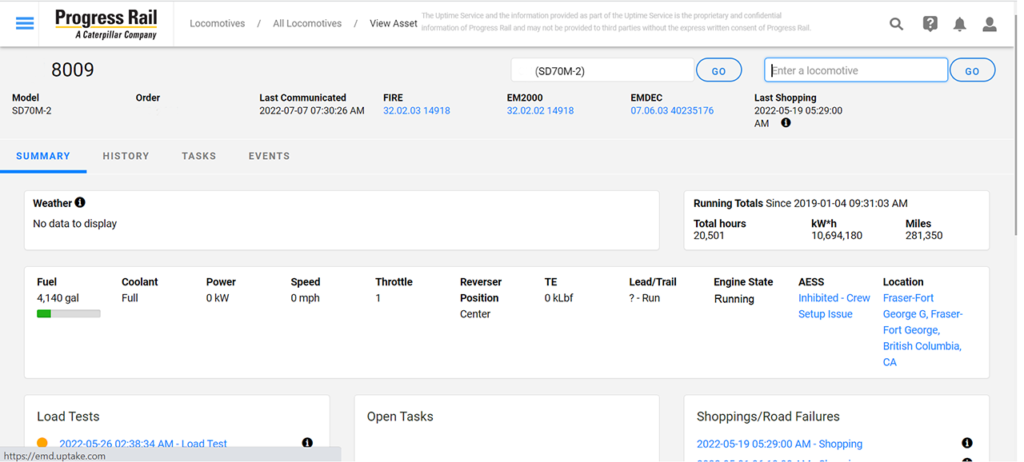
PR Uptime™ from original equipment manufacturer (OEM) and integrated rail solutions provider Progress Rail, a Caterpillar Company, allows railroads to make proactive mission decisions based on predictive alerts and reduce service delays caused by mission failure. By enabling planned maintenance to replace unscheduled repairs, locomotives can generate more revenue at lower cost, the company says.
The PR Uptime™ Suite provides railroads with advanced asset monitoring by combining expertise from the company’s Locomotive Monitoring Center (LMC); Uptime Cloud for secure data distribution and storage; Uptime Connect for secure data collection and transmission; and Uptime Analytics to create measurable value in the shop, in the yard and on the track. PR Uptime™ dashboards give locomotive health indicators, locomotive utilization metrics and data that can lead to cost savings. According to Progress Rail, PR Uptime™ has been implemented across numerous fleets, both in the U.S. and internationally, with thousands of locomotives currently being monitored.
The data science process used to create the analytics models for PR Uptime™ runs on a powerful suite of proprietary technology. The process leverages various machine learning engines to solve various problems in the rail space. Uptime Analytics helps shops fix locomotives the first time they enter, leading to fewer repeat and unnecessary shoppings. The target repair and troubleshooting guides from Uptime Analytics focuses the repair work to the source of the problem, decreasing shop cycle times. User feedback and repair closeouts facilitate machine learning, allowing Uptime Analytics to continuously improve. All of this leads to improved availability of locomotives, the company says.
“We have strong rail industry knowledge, combined with available data to positively impact our customers’ bottom line,” Progress Rail says. “By delivering insights quickly, PR Uptime™ can alert users to a potential—or real—problem. Instead of stagnant data, the data is presented in an intuitive, actionable way.”
Progress Rail says it will continue to invest in technology to support its customers and Precision Scheduled Railroading, along with Positive Train Control (PTC) and other measures being taken to make railroads more efficient and safer in their operations. “We’ve established a core agnostic analytics platform to help improve reliability and maintainability to support our customers’ assets,” the company adds.
Wi-Tronix
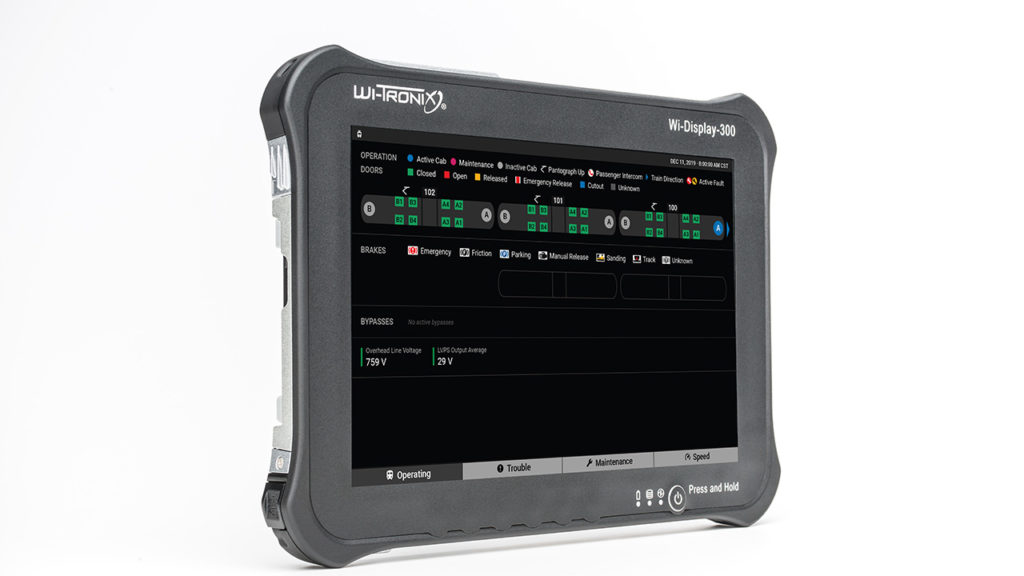
Wi-Tronix’s advances in remote health monitoring include its next-generation connected Violet event and digital video recorder solutions. All event recorder data is continuously synchronized to the cloud, enabling a self-monitoring event recorder solution with continuous signal level validation and reporting, reducing or eliminating maintenance time. Using powerful AI technology, video and audio data from a DVR is validated using sophisticated machine learning (ML) models. Images are automatically reviewed for quality and camera obstructions to provide real-time actionable notifications for immediate corrective action so that cameras record the data when it is needed most. Violet’s automated microphone performance validation occurs using real-world data combined with AI-based analysis to detect that the microphone and bell/horn is working as expected.
With the Connected Diagnostic System, operations centers and maintenance personnel are enabled to remotely see the real-time health and operating state of the vehicle for more accurate virtual troubleshooting of critical over-the-road incidents. With visibility to the exact same screens as the operator and to historical and active faults, Wi-Tronix says maintenance teams “can more efficiently resolve incidents and get trains moving again.”
ZTR
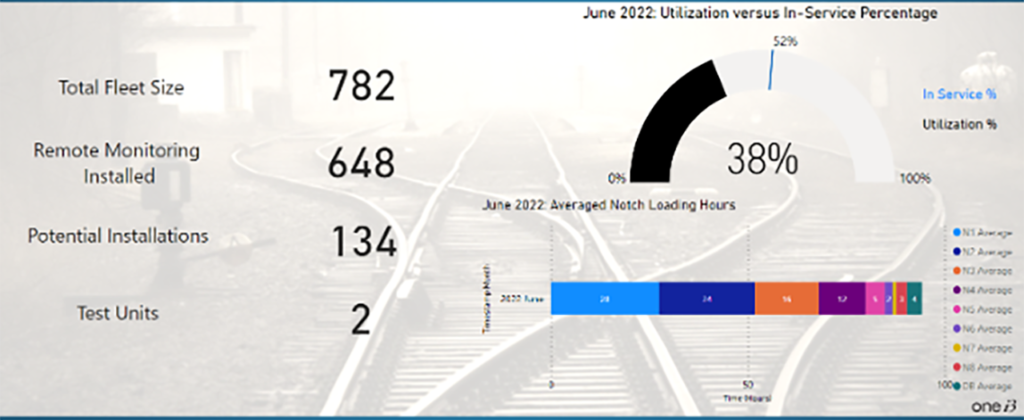
ZTR offers fleet and asset monitoring services that allow managers, technicians and operators to stay connected with their assets, helping to optimize asset uptime. ZTR, whose services go beyond GPS tracking, says it “implements advanced software systems to safely connect its proven rail products so users receive real-time operations monitoring, valuable sensor data, fuel metrics, asset performance and asset health.”
Additionally, advanced report analytics and a real-time dashboard assist in understanding fleet in-for-service time and utilization. ZTR says its reports have reduced shop dwell time by knowing what needs to be done even before an asset goes in for service.
ZTR says customers also benefit from working with its 24/7 technical support team, who can remotely troubleshoot complicated system issues, ultimately reducing troubleshooting time.
Nexxiot
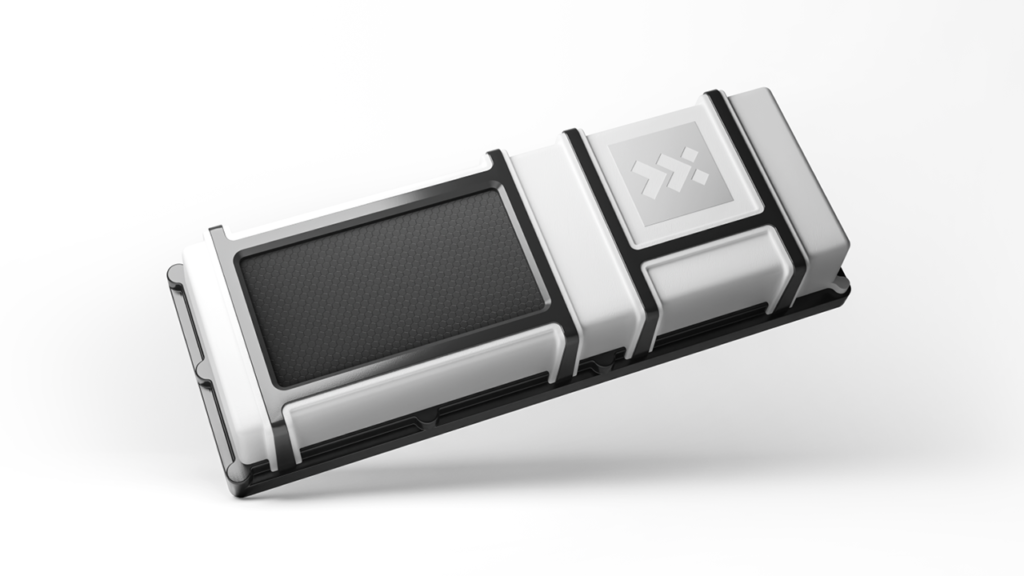
Nexxiot describes itself as “a TradeTech pioneer in sensing, connectivity and data analytics that creates game-changing capabilities for operators to optimize their fleet. Our clients manage operations, maintenance, service availability, fleet utilization, and extend product life with ATEX/Hazloc-certified maintenance-free devices that meet all AAR requirements.”
Nexxiot’s Globehopper Crossmodal is a zero-maintenance IoT hardware device deployed onto railcars and tank containers. Installed in under two minutes, it provides updates of location, utilization and sensor readings in real time. The data captured by the Crossmodal is processed in the Connect Intelligent Cloud—“a platform empowering operators with insights and unmatched visibility into cargo conditions.”
“Rail freight stakeholders are demanding visibility and accountability,” the company says. “Cargo owners and shippers want to know their goods will arrive OTIF (on time and in full). Real-time asset and cargo data from Nexxiot is processed to provide shippers, manufacturers, and retailers with reliable, cost-effective, high-quality transportation.
“There are layers of governance around processes, but data governance is relatively new. How should data be structured? How can we share it with confidence? How can we collaborate with better tools across the organization? How can we move forward in digitalization? Rail operators are shifting to see data as a core asset, and clients require experienced innovation partners who understand the business’s tough physical reality. Nexxiot delivers meaningful data for easier, safer, cleaner global transportation.”



